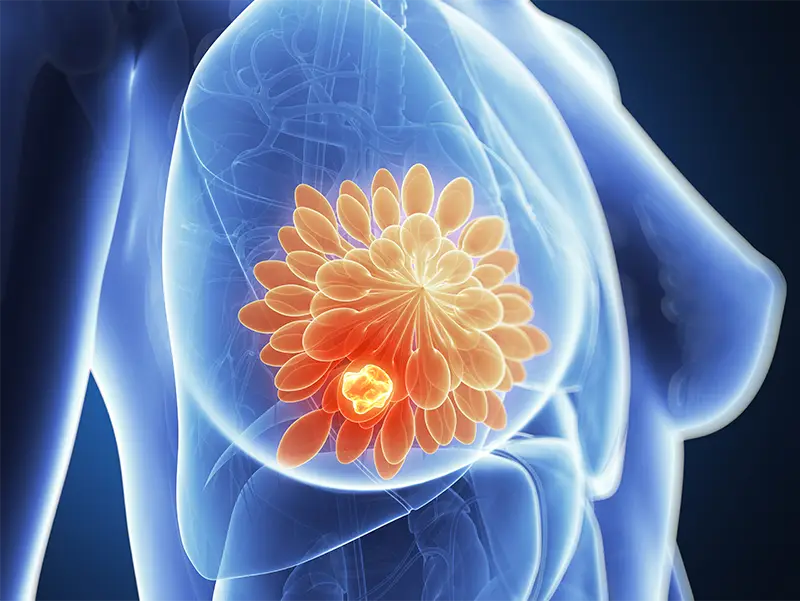Results from the multi-center I-SPY 2.2 trial demonstrate promise for a neoadjuvant treatment strategy to treat early-stage breast cancer in women with an immune-positive subtype and those with a hard-to-treat hormone-negative/immune-negative/DRD-negative subtype.
NewYork-Presbyterian and Columbia oncologist Meghna S. Trivedi, MD, MS, is the site principal investigator for the I-SPY 2.2 trial, a phase II neoadjuvant sequential, multiple-assignment randomization trial for high-risk stage II/III breast cancer that evaluates novel drug combinations based on a unique set of biomarkers called the “response-predictive subtype” (RPS).
Dr. Trivedi was the co-chaperone for the arm within the ISPY2.2 trial which examined the use of datopotamab deruxtecan (Dato-DXd), an antibody-drug conjugate, in combination with durvalumab, a programmed cell death-ligand 1 inhibitor, as the first sequence of therapy for patients with high-risk stage II/III breast cancer. The findings were recently presented at the 2024 European Society for Medical Oncology (ESMO) Congress and published in Nature Medicine.
Below, Dr. Trivedi shares results from the Dato-DXd plus durvalumab arm of the I-SPY 2.2 trial and explains how these types of studies can help tailor treatments to individual patients and reduce unnecessary treatment toxicity.
Trial Design
The I-SPY 2.2 trial includes three sequential blocks of treatment: initial randomization to experimental agent(s) as block A, a taxane-based regimen tailored to tumor subtype as block B if further escalation is needed, and finally doxorubicin/cyclophosphamide as block C if further escalation is needed. The treatment assignment/randomization is based on the RPS, which is defined by hormone receptor status, HER2 status, predicted benefit derived from immunotherapy, DNA damage repair deficiency (DRD), and luminal signaling.
Over the course of each block, the patient is evaluated for response to therapy with breast magnetic resonance imaging (MRI) and core biopsies as part of the predicted residual cancer burden (pre-RCB) assessment. The pre-RCB guides the decision-making for de-escalation or early escalation of therapy in the I-SPY 2.2 trial. The goal of the treatment strategy is to achieve a pathologic complete response (pCR).

The I-SPY 2.2 trial is a phase II neoadjuvant sequential, multiple-assignment randomization trial for high-risk stage II/III breast cancer that evaluates the use of Dato-DXd in combination with durvalumab as the first sequence of therapy for patients with high-risk stage II/III breast cancer.
A drug or combination of drugs can graduate from the I-SPY 2.2 trial by surpassing the subtype-specific threshold for modeled rate of pCR in Block A or by achieving a meaningful improvement in the subtype-specific modeled rate of pCR compared to the dynamic control group.
In this arm of the I-SPY 2.2 trial, we evaluated Dato-DXd in combination with durvalumab in Block A in patients with high-risk stage II/III Her2-negative breast cancer.
An important finding in the immune-positive subtype was that 92% of those who achieved a pCR did so by the end of block B, thereby avoiding the need for doxorubicin/cyclophosphamide.
— Dr. Meghna Trivedi
Key Findings
Across the entire treatment strategy, total of 106 patients began treatment in the arm and 50% of patients achieved a pathologic complete response (pCR). In patients with the immune-positive subtype (N=47), Dato-DXd plus durvalumab met graduation criteria for block A alone. In the entire treatment strategy (blocks A + B + C), patients with the immune-positive subtype achieved the highest rate of pCR (79%); however, it was not significantly greater than the rate of pCR for the dynamic control group (78%). Despite not graduating in the entire treatment strategy, an important finding in the immune-positive subtype was that 92% of those who achieved a pCR did so by the end of block B, thereby avoiding the need for doxorubicin/cyclophosphamide.
Our findings from I-SPY 2.2 warrant further investigation of Dato-DXd plus durvalumab in a phase 3 trial, particularly in the immune-positive and HR-negative/immune-negative/DRD-negative subtypes.
— Dr. Meghna Trivedi
There was also positive news for patients with a hard-to-treat hormone receptor-negative/ immune-negative/DRD-negative subtype (N=23). This group graduated for the entire treatment strategy after demonstrating a pCR rate of 44%, compared with 16% for the dynamic control group.
Our findings from I-SPY 2.2 warrant further investigation of Dato-DXd plus durvalumab in a phase 3 trial, particularly in the immune-positive and HR-negative/immune-negative/DRD-negative subtypes.
Personalizing Medicine in Breast Cancer
The I-SPY 2.2 trial demonstrates the potential of personalized treatment in early stage breast cancer by using response-predictive subtypes and evaluation with breast MRI and biopsies to maximize treatment efficacy and minimize toxicity for the individual patient. The goal is to be judicious in making sure that patients are getting the treatment they need – whether that is in Block A, B, and/or C – to achieve a pCR.




